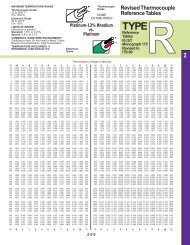Using Thermocouples
Using Thermocouples
Using Thermocouples
You also want an ePaper? Increase the reach of your titles
YUMPU automatically turns print PDFs into web optimized ePapers that Google loves.
The Reference Junction<br />
Cu<br />
+<br />
v<br />
–<br />
Cu<br />
Voltmeter<br />
Cu<br />
+ –<br />
Cu V2<br />
+<br />
–<br />
C<br />
V 1<br />
J 1<br />
+<br />
–<br />
v<br />
+<br />
V 2<br />
–<br />
+ T<br />
V 1<br />
–<br />
J 1<br />
EXTERNAL REFERENCE JUNCTION<br />
Figure 5<br />
One way to determine the temperature of J 2 is to<br />
physically put the junction into an ice bath, forcing its<br />
temperature to be 0ºC and establishing J 2 as the<br />
Reference Junction. Since both voltmeter terminal<br />
junctions are now copper-copper, they create no<br />
thermal emf and the reading V on the voltmeter is<br />
proportional to the temperature difference between J 1<br />
and J 2 .<br />
Now the voltmeter reading is (see Figure 5):<br />
V = (V 1 - V 2 ) ≅α(t J1 - t J2 )<br />
If we specify T J1 in degrees Celsius:<br />
T J1 (ºC) + 273.15 = t J1<br />
then V becomes:<br />
V = V 1 - V 2 = α [(T J1 + 273.15) - (T J2 + 273.15)]<br />
= α (T J1 - T J2 ) = α (T J1 - 0)<br />
V = αT J1<br />
J 2<br />
Ice Bath<br />
J 2<br />
T=0°C<br />
The copper-constantan thermocouple shown in<br />
Figure 5 is a unique example because the copper wire<br />
is the same metal as the voltmeter terminals. Let’s use<br />
an iron-constantan (Type J) thermocouple instead of the<br />
copper-constantan. The iron wire (Figure 6) increases<br />
the number of dissimilar metal junctions in the circuit, as<br />
both voltmeter terminals become Cu-Fe thermocouple<br />
junctions.<br />
V 3<br />
J 3<br />
- +<br />
+<br />
v V 1<br />
–<br />
- +<br />
V 1 = V<br />
Voltmeter<br />
V 4 J 4<br />
if V<br />
3 = V4<br />
i.e., if<br />
T J 3<br />
= T J4<br />
JUNCTION VOLTAGE CANCELLATION<br />
Figure 7<br />
Z<br />
We use this protracted derivation to emphasize that<br />
the ice bath junction output, V 2 , is not zero volts. It is a<br />
function of absolute temperature.<br />
By adding the voltage of the ice point reference<br />
junction, we have now referenced the reading V to 0ºC.<br />
This method is very accurate because the ice point<br />
temperature can be precisely controlled. The ice point is<br />
used by the National Bureau of Standards (NBS) as the<br />
fundamental reference point for their thermocouple<br />
tables, so we can now look at the NBS tables and<br />
directly convert from voltage V to Temperature T J1 .<br />
Cu<br />
+<br />
v<br />
–<br />
Cu<br />
J 3<br />
J 4<br />
Fe<br />
Fe<br />
J 2<br />
Ice Bath<br />
IRON-CONSTANTAN COUPLE<br />
Figure 6<br />
C<br />
J 1<br />
Z-22<br />
If both front panel terminals are not at the same<br />
temperature, there will be an error. For a more precise<br />
measurement, the copper voltmeter leads should be<br />
extended so the copper-to-iron junctions are made on<br />
an isothermal (same temperature) block:<br />
Cu<br />
+<br />
v<br />
–<br />
Cu<br />
Voltmeter<br />
Cu<br />
Cu<br />
J 3<br />
J 4<br />
Ice Bath<br />
REMOVING JUNCTIONS FROM DVM TERMINALS<br />
Figure 8<br />
Fe<br />
Isothermal Block<br />
The isothermal block is an electrical insulator but a<br />
good heat conductor, and it serves to hold J 3 and J 4 at<br />
the same temperature. The absolute block temperature<br />
is unimportant because the two Cu-Fe junctions act in<br />
opposition. We still have<br />
V = α (T 1 - T REF )<br />
Fe<br />
V 2<br />
T REF<br />
C<br />
T 1














